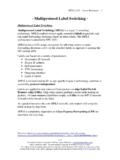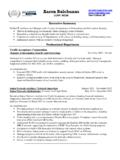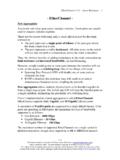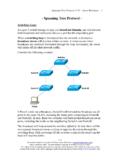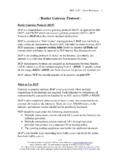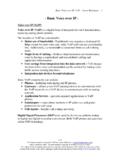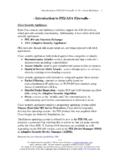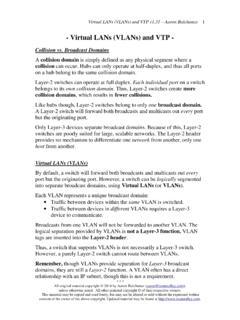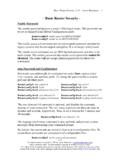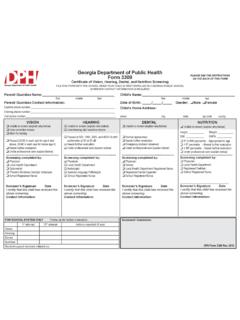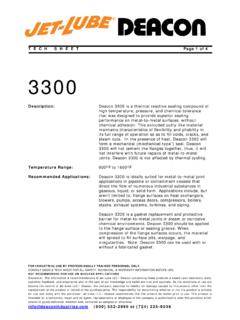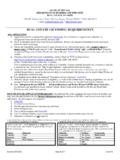Transcription of IS-IS - Router Alley
1 IS-IS Aaron Balchunas * * * All original material copyright 2007 by Aaron Balchunas unless otherwise noted. All other material copyright of their respective owners. This material may be copied and used freely, but may not be altered or sold without the expressed written consent of the owner of the above copyright. Updated material may be found at 1 - IS-IS - IS-IS Fundamentals IS-IS (Intermediate System -to- Intermediate System) is a standardized link-state protocol that was developed to be the definitive routing protocol for the OSI (Open Systems Interconnect) Model, which was developed by ISO (International Standards Organization). IS-IS shares many similarities to OSPF.
2 Though it was designed as an interior gateway protocol (IGP), IS-IS is predominantly used by ISPs, due to its scalability. IS-IS adheres to the following Link State characteristics: IS-IS allows for a hierarchical network design using Areas. IS-IS will form neighbor relationships with adjacent routers of the same IS-IS type. Instead of advertising the distance to connected networks, IS-IS advertises the status of directly connected links in the form of Link-State Packets (LSPs). IS-IS will only send out updates when there is a change to one of its links, and will only send the change in the update. IS-IS uses the Dijkstra Shortest Path First algorithm to determine the shortest path.
3 IS-IS is a classless protocol, and thus supports VLSMs. Other characteristics of IS-IS include: IS-IS was originally developed to route the ISO address space, and thus is not limited to IP routing. IS-IS routes have an administrative distance is 115. IS-IS uses an arbitrary cost for its metric. IS-IS additionally has three optional metrics: delay, expense, and error. Cisco does not support these optional metrics. IS-IS has no hop-count limit. The IS-IS process builds and maintains three separate tables: A neighbor table contains a list of all neighboring routers. A topology table contains a list of all possible routes to all known networks within an area.
4 A routing table contains the best route for each known network. IS-IS is only available on enterprise versions of the Cisco IOS. IS-IS Aaron Balchunas * * * All original material copyright 2007 by Aaron Balchunas unless otherwise noted. All other material copyright of their respective owners. This material may be copied and used freely, but may not be altered or sold without the expressed written consent of the owner of the above copyright. Updated material may be found at 2 IS-IS Protocols and Addressing IS-IS consists of three sub-protocols that work in tandem to achieve end-to-end routing which ISO defined as Connectionless Network Service (CLNS): CLNP (Connectionless Network Protocol) serves as the Layer-3 protocol for IS-IS (and was developed by ISO).
5 ES-IS (End System -to- Intermediate System) used to route between hosts and routers. IS-IS (Intermediate System -to- Intermediate System) used to route between routers. IS-IS was originally developed to route ISO CLNP addresses (outlined in RFC 1142). However, CLNP addressing never became prominently used. Thus, IS-IS was modified to additionally support IP routing, and became Integrated (or Dual) IS-IS (outlined in RFC 1195). The IS-IS CLNP address is hexadecimal and of variable length, and can range from 64 to 160 bits in length. The CLNP address contains three sections, including: Area field (variable length) ID field (from 8 to 64 bits, though usually 48 bits) Selector (SEL) field - (8 bits) Thus, the CLNP address identifies the Area in which a device is located, the actual host ID, and the destination application on that host, in the form of the SEL field.
6 The CNLP address is logically segmented even further, as demonstrated by the following table: IDP DSP AFI IDI HO-DSP System-ID NSEL Area Field ID Field SEL Field Observe the top row of the above figure. The ISO CLNP address provides granular control by separating internal and external routing information: The IDP (Initial Domain Part) portion of the address identifies the Autonomous System of the device (and is used to route to or between Autonomous Systems) The DSP (Domain Specific Part) portion of the address is used to route within the autonomous system. IS-IS Aaron Balchunas * * * All original material copyright 2007 by Aaron Balchunas unless otherwise noted.
7 All other material copyright of their respective owners. This material may be copied and used freely, but may not be altered or sold without the expressed written consent of the owner of the above copyright. Updated material may be found at 3 IS-IS Protocols and Addressing (continued) IDP DSP AFI IDI HO-DSP System-ID NSEL Area Field ID Field SEL Field The IDP portion of the address is separated into two sections, including: AFI (Authority and Format Identifier) specifies the organization authorized to assign addresses, and the format and length of the rest of the CLNP address. The AFI is always 8 bits. IDI (Initial Domain Identifier) identifies the sub-organization under the parent AFI organization.
8 The length of the IDI is dependent on the chosen AFI. An AFI of 0x49 indicates a private CLNP address, which cannot be routed globally (the equivalent of an IPv4 private address). An AFI of 0x47 is commonly used for global IS-IS networks, with the IDI section identifying specific organizations. The AFI plus the IDI essentially identify the autonomous system of the address. However, this is not the equivalent of a BGP AS number, nor is it compatible with BGP as an exterior routing protocol. The DSP portion of the address is separated into three sections, including: HO-DSP (High Order DSP) identifies the area within an autonomous system System ID identifies the specific host.
9 Usually 48 bits (or 6 octets) in length, to accommodate MAC addresses NSEL identifies the destination upper layer protocol of the host (always 8 bits) Two types of CLNP addresses are defined: NET address does not contain upper-layer information (in other words, the SEL field is always set to 0x00) NSAP address the full CLNP address, with populated Area, ID, and SEL fields. Please note: A NET address is simply an NSAP address with a zero value in the SEL field. IS-IS Aaron Balchunas * * * All original material copyright 2007 by Aaron Balchunas unless otherwise noted. All other material copyright of their respective owners. This material may be copied and used freely, but may not be altered or sold without the expressed written consent of the owner of the above copyright.
10 Updated material may be found at 4 CLNS Address Example The following is an example of a full ISO CLNS address: Correlating the above address to the appropriate fields: IDP DSP AFI IDI HO-DSP System-ID NSEL 47. 0001. 00 Area Field ID Field SEL Field The System-ID is usually populated by the device s MAC address or IP v4 address. Recall that CLNS addresses are of variable length. We can specify addresses without an IDI field: Thus, the above address contains an AFI (Autonomous System), HO-DSP (Area), System-ID (in this example, a MAC Address), and the NSEL (SEL). Because the SEL field has a zero value (0x00), the above address is defined as a NET address, and not an NSAP address.

